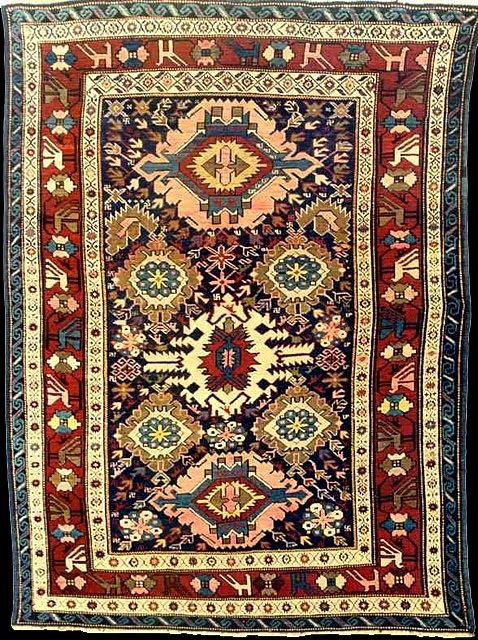|
Antique Kuba rug,
so called "Molla Kamalli" design, third quarter 19th century, Devechi-Shabran
District, Southern Lowland Kuba Region, North East
Azerbaijan, 110 x 155 cm
|
|
Kuba Floral &
Heraldic Palmette Pattern
Knot: symmetric slightly open to the right soft wool short clipped.
Density: H38/10cm V42/10cm 1596/dm² ; H 9-10/pi V 10-11/pi 98/psi
Warps: fine white wool, finely twisted, Z2S, slightly depressed
Wefts: medium brown wool, 2 shoots
Selvage: flat selvage, 3 cords of 2 warps with interwoven brown ground wefts
and overcast with medium blue wool.
Colours: natural, white, different shade of light to dark blue, olive,
madder red, pink, oxidized black and dark brown, light yellow, medium brown.
Ends: warp fringes
Related examples:
1/ Bennett Caucasian
plate 307 page 239
He makes the following
comments: It is obviously close in concept to the large floral carpets of
the late 17th and 18th centuries
.
2/Wright and Wertime Caucasian Carpets & Covers picture 23 page 67 in
the top left corner of a 1913 photograph of a Kuba rug display from the
Second All Empire Kustar Exhibition.
3/ Wright and Wertime Caucasian Carpets & Covers picture 63 page 155 a
1926 photograph from the Zakgostorg (which replaced the Kustar Committee)
exhibition in Kuba.
4/ This kind of palmette are also found in Sumacs from this area. Look at
the left and right rows of palmettes of - Bennett Caucasian plate 471
page 356
5/ To notice in all this rug the high Persian influence and the use of very
unusual main borders.
Picture and
information from spongobongo.com
 |

